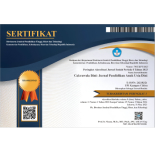Implementation of Long-Project Storytelling in Developing Children’s Creativity Through the Reggio Emilia Approach
Abstract
Keywords
Full Text:
PDFReferences
Astuti, R., and Aziz, T. (2019). Integrasi pengembangan kreativitas anak usia dini di TK Kanisius Sorowajan Yogyakarta. Jurnal Obsesi: Jurnal Pendidikan Anak Usia Dini, 3(2), 294-302.
Broemmel, A. D. (1999). The Impact of animated books on the vocabulary and languages development of preschool-aged children in two school settings. University of Tennessee.
Dadvar, R. (2012). The relationship between emotional intelligence and creativity of female high school students in baft city. Journal of Basic and Applied Scientific Research, 2(4), 4174-4183.
Dere, Z. (2019). Investigating the creativity of children in early childhood education institutions. Universal Journal of Educational Research, 7(3), 652-658.
Devianty, R. (2019). Membangun bahasa komunikatif untuk anak usia dini. Jurnal Nazhamiyah.
Fakhriyani, D. (2016). Pengembangan kreativitas anak usia dini. Jurnal Pemikiran Penelitian Pendidikan dan Sains Wacana Didaktika, 4(2), 193 – 200.
Gryazeva-Dobshinskaya, V. G., Dmitrieva, Y. A., Korobova, S. Y., & Glukhova, V. A. (2020). Children’s creativity and personal adaptation resources. Behavioral Sciences, 10(2), 1-11
Hasim, E. (2008). Penggunaan media kata bergambar dalam upaya meningkatkan kualitas pembelajaran membaca dan menulis permulaaan di kelas satu sekolah dasar. Jurnal Penelitian dan Pendidikan, 5(2), 78-87.
Hidayat, D. B. (2019). Efektivitas metode mendongeng (storytelling) dalam meningkatkan keterampilan berbicara dan keterampilan membaca siswa (sebuah studi kasus di SDN 55 Bengkulu Selatan. Jurnal Pembelajaran dan Pengajaran Pendidikan Dasar, 2(2), 120-128.
Hoffmann, J. D., & Russ, S. W. (2016). Fostering pretend play skills and creativity in elementary school girls: A group play intervention. Psychology of Aesthetics, Creativity, and the Arts, 10(1), 114–125.
Inten, D. N. (2017). Peran keluarga dalam menanamkan literasi dini pada anak. Golden Age: Jurnal Pendidikan Anak Usia Dini, 1(1), 23-32.
Karyadi, A. C. (2018). Peningkatan keterampilan berbicara melalui metode storytelling menggunakan media big book. Jurnal Pengabdian Masyarakat Ilmu Keguruan dan Pendidikan (JPM-IKP), 1(2), 81-90.
Kaufman, S. B. (2013). Opening up openness to experience: A four‐factor model and relations to creative achievement in the arts and sciences. The Journal of Creative Behavior, 47(4), 233-255.
Martaida, T., Bukit, N., & Ginting, E. M. (2017). The effect of discovery learning model on student’s critical thinking and cognitive ability in junior high school. IOSR Journal of Research and Method in Education (IOSR-JRME), 7(6), 1-8.
Milana, H. (2021). Meningkatkan perkembangan bahasa anak melalui metode story telling, model talking stick dan model picture and picture pada anak usia dini. Jurnal Tugas Akhir Mahasiswa PG PAUD (JIKAD), 1(1), 8-12.
Miranda, D. (2016). Upaya guru dalam mengembangkan kreativitas anak usia dini di Kota Pontianak. Jurnal Pembelajaran Prospektif, 1(1), 60 - 67.
Morgan, A. M. (2012). Language, literacy, literature: Using storytelling in the languages classroom. Journal Classroom Language and Literacy Learning, 46(2), 1-10.
Oktiawati, A., Widodo, Y. P., and Istianah, N. (2020). Storytelling media boneka jari kain flanel meningkatkan kecerdasan emosional anak usia prasekolah. Bhamada: Jurnal Ilmu dan Teknologi Kesehatan (E-Journal), 11(2), 9-9.
Permana, E. P. (2015). Pengembangan media pembejaran boneka kaus kaki untuk meningkatkan keterampilan berbicara siswa kelas II sekolah dasar. Jurnal Profesi Pendidikan Dasar, 2(2), 133 – 140.
Rabi, N. M., and Masran M. N. B. (2016). Creativity characteristic in teaching students with learning disabilities among pre-service teachers in UPSI. International Journal of Advanced and Applied Sciences, 3(11), 66-72.
Rohman, S. (2017). Membangun budaya membaca pada anak melalui program gerakan literasi sekolah. TERAMPIL: Jurnal Pendidikan dan Pembelajaran Dasar, 4(1), 151-174.
Saavedra, E. (1993). Complex Interdependence in Task-performing Groups. Journal of Applied Psychology, 78(1), 61-72.
Salsabila, A. T. (2021). Pengaruh Storytelling dalam meningkatkan kemampuan empati anak usia dini. Jurnal Pendidikan Anak, 10(2), 164-171.
Subkhan, E. (2013). Toward critical educational technology for early childhood education. indonesian. Journal of Early Childhood Education Studies, 2(1), 1-8.
Syamsuardi, S. M. (2022). Metode storytelling dengan musik instrumental untuk meningkatkan kemampuan menyimak dan berbicara anak. Jurnal Obsesi: Jurnal Pendidikan Anak Usia Dini, 6(1), 163-172.
DOI: https://doi.org/10.17509/cd.v15i1.57988
Refbacks
- There are currently no refbacks.
Copyright (c) 2024 UPI Kampus Cibiru

This work is licensed under a Creative Commons Attribution-ShareAlike 4.0 International License.
Cakrawala Dini: Jurnal Pendidikan Anak Usia Dini
Published in collaboration Program Studi PGPAUD UPI Kampus Cibiru, APG PAUD Indonesia, and PPJ PAUD Indonesia

Cakrawala Dini: Jurnal Pendidikan Anak Usia Dini is licensed under a Creative Commons Attribution-ShareAlike 4.0 International License.
Based on a work at https://ejournal.upi.edu/index.php/cakrawaladini.















